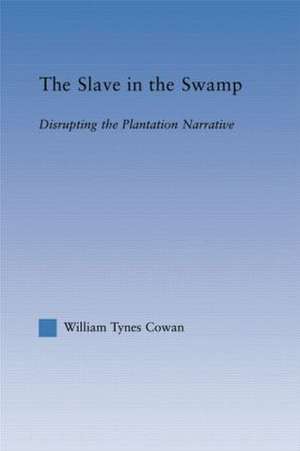The Slave in the Swamp: Disrupting the Plantation Narrative: Literary Criticism and Cultural Theory
Autor William Tynes Cowaen Limba Engleză Paperback – 23 apr 2015
| Toate formatele și edițiile | Preț | Express |
|---|---|---|
| Paperback (1) | 448.44 lei 6-8 săpt. | |
| Taylor & Francis – 23 apr 2015 | 448.44 lei 6-8 săpt. | |
| Hardback (1) | 1335.94 lei 6-8 săpt. | |
| Taylor & Francis – 13 dec 2004 | 1335.94 lei 6-8 săpt. |
Din seria Literary Criticism and Cultural Theory
- 9%
 Preț: 935.20 lei
Preț: 935.20 lei - 9%
 Preț: 1037.81 lei
Preț: 1037.81 lei -
 Preț: 310.03 lei
Preț: 310.03 lei - 18%
 Preț: 1053.16 lei
Preț: 1053.16 lei - 18%
 Preț: 1003.99 lei
Preț: 1003.99 lei - 18%
 Preț: 1005.39 lei
Preț: 1005.39 lei - 18%
 Preț: 1102.88 lei
Preț: 1102.88 lei - 18%
 Preț: 1054.58 lei
Preț: 1054.58 lei - 18%
 Preț: 998.71 lei
Preț: 998.71 lei - 18%
 Preț: 701.56 lei
Preț: 701.56 lei - 18%
 Preț: 1109.78 lei
Preț: 1109.78 lei - 18%
 Preț: 1054.61 lei
Preț: 1054.61 lei - 18%
 Preț: 1062.98 lei
Preț: 1062.98 lei - 18%
 Preț: 1051.55 lei
Preț: 1051.55 lei - 15%
 Preț: 697.34 lei
Preț: 697.34 lei - 18%
 Preț: 1050.16 lei
Preț: 1050.16 lei - 18%
 Preț: 997.90 lei
Preț: 997.90 lei - 26%
 Preț: 819.09 lei
Preț: 819.09 lei - 26%
 Preț: 766.12 lei
Preț: 766.12 lei - 18%
 Preț: 997.45 lei
Preț: 997.45 lei - 18%
 Preț: 998.26 lei
Preț: 998.26 lei - 28%
 Preț: 490.08 lei
Preț: 490.08 lei - 18%
 Preț: 998.88 lei
Preț: 998.88 lei - 18%
 Preț: 1109.18 lei
Preț: 1109.18 lei - 18%
 Preț: 1105.24 lei
Preț: 1105.24 lei - 26%
 Preț: 766.12 lei
Preț: 766.12 lei - 18%
 Preț: 1000.61 lei
Preț: 1000.61 lei - 18%
 Preț: 999.82 lei
Preț: 999.82 lei - 26%
 Preț: 819.48 lei
Preț: 819.48 lei - 26%
 Preț: 763.78 lei
Preț: 763.78 lei - 18%
 Preț: 779.28 lei
Preț: 779.28 lei - 17%
 Preț: 245.56 lei
Preț: 245.56 lei - 18%
 Preț: 1106.81 lei
Preț: 1106.81 lei - 18%
 Preț: 998.56 lei
Preț: 998.56 lei - 26%
 Preț: 877.30 lei
Preț: 877.30 lei - 18%
 Preț: 999.46 lei
Preț: 999.46 lei - 26%
 Preț: 819.09 lei
Preț: 819.09 lei - 15%
 Preț: 673.44 lei
Preț: 673.44 lei -
 Preț: 365.87 lei
Preț: 365.87 lei - 18%
 Preț: 1052.35 lei
Preț: 1052.35 lei - 18%
 Preț: 1057.05 lei
Preț: 1057.05 lei - 18%
 Preț: 944.11 lei
Preț: 944.11 lei - 18%
 Preț: 1056.28 lei
Preț: 1056.28 lei - 26%
 Preț: 763.39 lei
Preț: 763.39 lei - 26%
 Preț: 819.09 lei
Preț: 819.09 lei - 25%
 Preț: 766.66 lei
Preț: 766.66 lei - 18%
 Preț: 997.45 lei
Preț: 997.45 lei - 26%
 Preț: 820.32 lei
Preț: 820.32 lei - 18%
 Preț: 731.71 lei
Preț: 731.71 lei - 18%
 Preț: 1002.36 lei
Preț: 1002.36 lei
Preț: 448.44 lei
Nou
Puncte Express: 673
Preț estimativ în valută:
85.82€ • 88.66$ • 71.42£
85.82€ • 88.66$ • 71.42£
Carte tipărită la comandă
Livrare economică 26 martie-09 aprilie
Preluare comenzi: 021 569.72.76
Specificații
ISBN-13: 9781138868656
ISBN-10: 1138868655
Pagini: 296
Dimensiuni: 152 x 229 x 16 mm
Greutate: 0.43 kg
Ediția:1
Editura: Taylor & Francis
Colecția Routledge
Seria Literary Criticism and Cultural Theory
Locul publicării:Oxford, United Kingdom
ISBN-10: 1138868655
Pagini: 296
Dimensiuni: 152 x 229 x 16 mm
Greutate: 0.43 kg
Ediția:1
Editura: Taylor & Francis
Colecția Routledge
Seria Literary Criticism and Cultural Theory
Locul publicării:Oxford, United Kingdom
Cuprins
Chapter 1 Introduction: Into the Dismal Swamp; Identity and the Dynamics of Space; Chapter 2 Sambo, Nat, and the Gentleman Planter: Notions of Self on the Plantation; Chapter 3 The Slave in the Swamp: Claiming Space; Chapter 4 John Pendleton Kennedy's Swallow Barn and the Birth of Plantation Literature; Literary Swamps of the 1850s; Chapter 5 Proslavery Writers in the Wake of Uncle Tom's Cabin; Chapter 6 African American Views of the Swamp: Slave Narratives and Early Fiction; Chapter 7 Stowe's Dred and the Discourse of Violence in the 1850s; Reconciliation and Lost Cause; Chapter 8 Dredging the Swamps: Joel Chandler Harris and the Packaging of African American Folklore; Chapter 9 The Cult of the Lost Cause and Thomas Nelson Pages “No Haid Pawn”; Chapter 10 George Washington Cable's The Grandissimes and Plantation Narrative(s); Chapter 11 Conclusion: The Body of the Maroon;


















